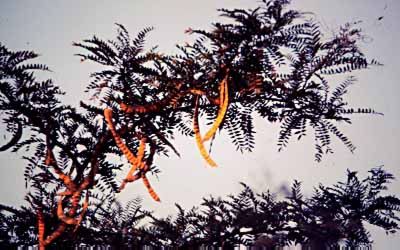Genus: Gleditsia
Nomenclature
Gleditsia L., Sp. Pl. 2: 1056. 1753. Gen. Pl. ed. 5. 476. 1754. Caesalpiniodes Kuntze, Revis. Gen. Pl. 1: 166. 1891, nom. illeg. (Art. 52.1). TYPE: Gleditsia triacanthos L.Melilobus Mitch. ex Raf., Sylva Tellur. 121. 1838. TYPE: Melilobus heterophyla Raf. (=Gleditsia triacanthos L.).
Key to the species of Gleditsia
List of Gleditsia Species
References to Gleditsia
- Andrews, L. 1902. Gleditsia triacanthos established in Connecticut. Rhodora 4: 103-4.
- Appleton, B. et.al. 1999. Evaluating trees for saltwater spray tolerance for oceanfront sites. J. Arboric. 25: 205-209.
- Atchison, E. 1949. Chromosome numbers in the Leguminosae. IV. Chromosome numbers and geographical relationships of miscellaneous Leguminosae. J. Elisha Mitchell Sci. Soc. 65: 118-22.
- Blaser, H. W. 1956. Morphology of the determinate thorn-shoots of Gleditsia. Amer. J. Bot. 43: 22-7.
- Boerner, R. E. J.; Brinkman, J. A. 1996. Ten years of tree seedling establishment and mortality in an Ohio deciduous forest complex. Bull. Torrey Bot. Club 123: 309-17.
- Bump, N. G. 1926. Some observations of forest tree seeds and the early development of the seedlings. M.S. Thesis Cornell Univ., Ithaca, NY64 p.
- Burton, P. J.; Bazzaz, F. A. 1991. Tree seedling emergence on interactive temperature and moisture gradients and in patches of old-field vegetation. Amer. J. Bot. 78(1): 131-49.
- Buton, P. J.; Bazzaz, F. A. 1995. Ecophysiological responses of tree seedlings invading different patches of old-field vegetation. J. Ecol. 83: 99-112.
- Dirr, M. A. 1974. Tolerance of honeylocust seedlings to soil-applied salts. Hortscience 9: 53-4.
- Fordham, A. J. 1965. Germination of woody legume seeds with impermeable seed coats. Arnoldia (Jamaica Plain) 25: 1-8.
- Fordyce, J. A.; Ehrle, E. B.; Thompson, P. W. 1996. The big trees of Michigan: 14. Gleditsia triacanthos L. Michigan Bot. 35: 51-3.
- Gold, M. A.; Hanover, J. W. 1993. Honeylocust (Gleditsia triacanthos), a multipurpose tree for the temperate zone. International Tree Crops Journal 7: 189-207.
- Gordon, D. 1966. A revision of the genus Gleditsia (Leguminosae). Ph.D. Dissertation Indiana Univ., Bloomington, IN114 p.
- Graves, W. R. 1994. Urban soil temperatures and their potential impact on tree growth. J. Arboric. 20(1): 24-7.
- Grisiuk, N. M. 1958. Polygamy and monoeciousness in Gleditsia triacanthos L. Bot. Zhurn. (Moscow & Lenengrad) 43: 1488-90. (In Russian)
- Halverson, H. G.; Potts, D. F. 1981. Water requirements of honey locust (Gleditsia triacanthos f. inermis) in the urban forest.
- Karnosky, D. F. 1981. Chamber and field evaluations of air pollution tolerances of urban trees. J. Arboric. 7: 99-105. (Sulphur dioxide, ozone, & oxidants)
- McDougall, W. B. 1921. Thick-walled root hairs of Gleditsia and related genera. Amer. J. Bot. 8: 171-5.
- Michener, D. C. 1986. Phenotypic instability in Gleditsia triacanthos (Fabaceae). Brittonia 38(4): 360-1.
- Murphy, H. T.; Lovett Doust, J. 2004. Landscape-level effects on developmental instability: fluctuating asymmetry across the range of honey locust, Gleditsia triacanthos (Fabaceae). Int. J. Plant Sci. 165: 795-803.
- Owens, S. J.; Lewis, G. P. 1996. Stigma morphology in the Leguminosae: The wet, papillate (WP) stigma in Caesalpinioideae. Kew Bull. 51(1): 119-31.
- Parrish, J. A. D.; Bazzaz, F. A. 1982. Niche responses of early and late successional tree seedlings on three resource gradients. Bull. Torrey Bot. Club 109(4): 451-6.
- Potts, D. F.; Herrington, L. P. 1982. Drought resistance adaptations in urban honeylocust. J. Arboric. 8(3): 75-80.
- Rembert, D. H. 1969. Comparative megasporogenesis in Caesalpiniaceae. Bot. Gaz. 130(1): 47-52.
- Rhoads, A. F.; Meyer, P. W.; Sanfelippo, R. 1981. Performance of urban street trees evaluated. J. Arboric. 7: 127-132.
- Robertson, K. R.; Lee, Y. T. 1976. The genera of Caesalpinioideae in the southeastern United States. J. Arnold Arbor. 57: 1-34.
- Santamour, F. S. 1977. Flavonoid distribution in Gleditsia. J. Arboric. 3(1): 14-8.
- Schnabel, A.; Hamrick, J. L. 1990. Organization of genetic diversity within and among populations of Gleditsia triacanthos (Leguminosae). Amer. J. Bot. 77(8): 1060-9.
- Schnabel, A.; Hamrick, J. L. 1995. Understanding the population genetic structure of Gleditsia triacanthos L.: The scale and pattern of pollen gene flow. Evolution 49(5): 921-31.
- Schnabel, A.; Laushman, R. H.; Hamrick, J. L. 1991. Comparative genetic structure of two co-occurring tree species, Maclura pomifera (Moraceae) and Gleditsia triacanthos (Leguminosae). Heredity 67: 357-64.
- Schnabel, A.; McDonel, P. E.; Wendel, J. F. 2003. Phylogenetic relationships in Gleditsia (Leguminosae) based on ITS sequences. Amer. J. Bot. 90: 310-320.
- Schnabel, A.; Wendel, J. F. 1998. Cladistic biogeography of Gleditsia (Leguminosae) based on ndhF and rpl16 chloroplast gene sequences. Amer. J. Bot. 85: 1753-1765. (Also Gymnocladus)
- Smith, G. C.; Brennan, E. G. 1984. Response of honeylocust cultivars to air pollution stress in an urban environment. J. Arboric. 10(11): 289-93. (Ozone)
- Sullivan, J. 1994. {Gleditsia tricanthos. ()
- Tucker, S. C. 1991. Helical floral organogenesis in Gleditsia, a primitive caesalpinoid legume. Amer. J. Bot. 78: 1130-49.
- Vrecenak, A. J.; Vodak, M. C.; Fleming, L. E. 1989. The influence of site factors on the growth of urban trees. J. Arboric. 15(9): 206-9.
